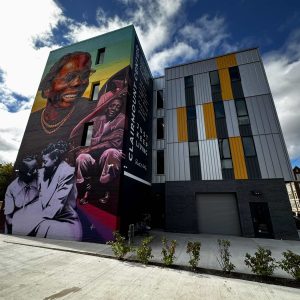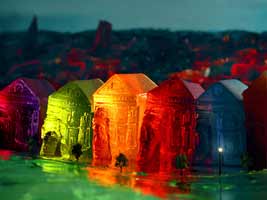Link About It: This Week’s Picks
SF guarantees income for trans people, Detroit’s Ruth Ellis Center has a new home and more from around the web

San Francisco Program Will Provide Guaranteed Income for Trans People
 San Francisco Mayor London Breed recently announced the Guaranteed Income for Transgender People (GIFT) program, a no-strings-attached monthly stipend that will be delivered for 18 months to low-income people who are transgender, nonbinary or gender diverse. GIFT will distribute $1,200 per month to 55 recipients who must be over the age of 18, live in San Francisco and make a maximum monthly income of $600. The program (which launches in January) seeks to help end trans homelessness, a pressing issue given that 29% of trans adults live in poverty and are twice as likely to be out of work compared to cisgender people according to a 2015 survey. This program is a radical first step toward ending trans poverty rates and mitigating financial gender inequities. Learn more about GIFT, which is currently accepting applications until 15 December, at them.
San Francisco Mayor London Breed recently announced the Guaranteed Income for Transgender People (GIFT) program, a no-strings-attached monthly stipend that will be delivered for 18 months to low-income people who are transgender, nonbinary or gender diverse. GIFT will distribute $1,200 per month to 55 recipients who must be over the age of 18, live in San Francisco and make a maximum monthly income of $600. The program (which launches in January) seeks to help end trans homelessness, a pressing issue given that 29% of trans adults live in poverty and are twice as likely to be out of work compared to cisgender people according to a 2015 survey. This program is a radical first step toward ending trans poverty rates and mitigating financial gender inequities. Learn more about GIFT, which is currently accepting applications until 15 December, at them.
Image courtesy of HUM Images/Universal Images Group/Getty Images
How Egg Whites Can Help Clean the Ocean
 Researchers at Princeton Engineering have discovered that egg whites can create cheap yet efficient filters, a critical finding that could help clean out the estimated 14 million tons of microplastics in the ocean. The research began when Craig Arnold, a co-author of the study, was eating lunch and realized the structure of his sandwich could be perfect for filtration. Exploring food led Arnold and engineering professors at Princeton University to egg whites, which they converted into a water-filtration system by freeze-drying them and then heating them up to nearly 900 degrees Celsius. This process transforms the texture into a lightweight and porous substance called an aerogel. Not only can this material be used for energy storage and sound and thermal insulation, but it can also filter salt and microplastics from seawater with 98% efficiency. Learn more about this innovative discovery at Modern Farmer.
Researchers at Princeton Engineering have discovered that egg whites can create cheap yet efficient filters, a critical finding that could help clean out the estimated 14 million tons of microplastics in the ocean. The research began when Craig Arnold, a co-author of the study, was eating lunch and realized the structure of his sandwich could be perfect for filtration. Exploring food led Arnold and engineering professors at Princeton University to egg whites, which they converted into a water-filtration system by freeze-drying them and then heating them up to nearly 900 degrees Celsius. This process transforms the texture into a lightweight and porous substance called an aerogel. Not only can this material be used for energy storage and sound and thermal insulation, but it can also filter salt and microplastics from seawater with 98% efficiency. Learn more about this innovative discovery at Modern Farmer.
Image courtesy of Shutterstock
Indigenous Restaurants in Seattle Work to Decolonize Dining
 On 29 November, the Indigenous-owned restaurant ʔálʔal Cafe will open in Seattle, joining other Native-owned eateries in the city like the pop-up Native Soul and acclaimed food truck Off the Rez. The new business—which will highlight Indigenous cuisine as well as art—continues the burgeoning movement in Seattle to empower the Native community and educate about their history in the city. Despite being named after Chief Si’ahl and having a food scene known for its many Indigenous ingredients (like salmon, berries, cedar and wild mushrooms), Seattle often erases its own roots. ʔálʔal Cafe hopes to change that by serving dishes crafted with ingredients from various tribal nations: blue corn from the Diné and Ute peoples, bison from the Cheyenne River Sioux Tribe and salmon from the Quinault Indian Nation. While the onus should not be on Indigenous people to educate others about their stolen resources, the new restauranteurs are rethinking what dining should look like, transforming Native cultivation, preparation and stories into delicious, inventive cuisine. Learn more at Eater.
On 29 November, the Indigenous-owned restaurant ʔálʔal Cafe will open in Seattle, joining other Native-owned eateries in the city like the pop-up Native Soul and acclaimed food truck Off the Rez. The new business—which will highlight Indigenous cuisine as well as art—continues the burgeoning movement in Seattle to empower the Native community and educate about their history in the city. Despite being named after Chief Si’ahl and having a food scene known for its many Indigenous ingredients (like salmon, berries, cedar and wild mushrooms), Seattle often erases its own roots. ʔálʔal Cafe hopes to change that by serving dishes crafted with ingredients from various tribal nations: blue corn from the Diné and Ute peoples, bison from the Cheyenne River Sioux Tribe and salmon from the Quinault Indian Nation. While the onus should not be on Indigenous people to educate others about their stolen resources, the new restauranteurs are rethinking what dining should look like, transforming Native cultivation, preparation and stories into delicious, inventive cuisine. Learn more at Eater.
Image courtesy of Off the Rez
Detroit’s New Affordable Housing and Health Center for LGBTQ+ People
 The Ruth Ellis Center is a Detroit non-profit dedicated to supporting LGBTQ+ youth. In October, they opened a permanent affordable housing and health facility for young queer people. The 46,000-square-foot building was carefully designed by Chicago architecture firm LBBA to cater to the unique needs of the community, from offering health and wellness services to addressing safety concerns. While maintaining pride for its residents, the building is equipped with heightened security measures, an important feature given rampant attacks on queer spaces like the recent shooting at Colorado Springs’ Club Q. The center also focuses on the need for community, incorporating different public spaces capable of hosting balls, fashion shows and other creative events, as well as an open-floor plan to invite the wider community and a new pharmacy as requested by neighbors. Even its materials are community-oriented, comprising details and finishes inspired by the local architectural style. Learn more about the vital space at Bloomberg.
The Ruth Ellis Center is a Detroit non-profit dedicated to supporting LGBTQ+ youth. In October, they opened a permanent affordable housing and health facility for young queer people. The 46,000-square-foot building was carefully designed by Chicago architecture firm LBBA to cater to the unique needs of the community, from offering health and wellness services to addressing safety concerns. While maintaining pride for its residents, the building is equipped with heightened security measures, an important feature given rampant attacks on queer spaces like the recent shooting at Colorado Springs’ Club Q. The center also focuses on the need for community, incorporating different public spaces capable of hosting balls, fashion shows and other creative events, as well as an open-floor plan to invite the wider community and a new pharmacy as requested by neighbors. Even its materials are community-oriented, comprising details and finishes inspired by the local architectural style. Learn more about the vital space at Bloomberg.
Image courtesy of Zach Mortice/Bloomberg CityLab
Digitizing Rare Edwardian Images That Are Too Fragile to Display
 In 1903, the Lumière brothers, Auguste and Louis, patented the first widely available color photography process, called autochrome. Their method—which involves dusting a plate with dyed potato starch particles before loading it into a camera—revolutionized photography and cinema, yet autochrome photos are rarely seen today. Extremely sensitive, with a single transparency, these images are ruined when exposed to light and thus hardly displayed—even at London’s Victoria and Albert Museum where there are over 2,500 autochrome photos, which have been taken by celebrated photographers as well as amateurs. A new book, Colour Mania: Photographing the World In Autochrome, by curator Catlin Langford, offers the world a glimpse of these images. Published by Thames & Hudson, the book presents the carefully digitized photographs while exploring autochrome’s impact and subsequent abandonment within an increasingly visual society. Learn more at The Times.
In 1903, the Lumière brothers, Auguste and Louis, patented the first widely available color photography process, called autochrome. Their method—which involves dusting a plate with dyed potato starch particles before loading it into a camera—revolutionized photography and cinema, yet autochrome photos are rarely seen today. Extremely sensitive, with a single transparency, these images are ruined when exposed to light and thus hardly displayed—even at London’s Victoria and Albert Museum where there are over 2,500 autochrome photos, which have been taken by celebrated photographers as well as amateurs. A new book, Colour Mania: Photographing the World In Autochrome, by curator Catlin Langford, offers the world a glimpse of these images. Published by Thames & Hudson, the book presents the carefully digitized photographs while exploring autochrome’s impact and subsequent abandonment within an increasingly visual society. Learn more at The Times.
Image by Mervyn O’Gorman (1913) courtesy of the artist and the Victoria and Albert Museum
Link About It is our filtered look at the web, shared daily in Link and on social media, and rounded up every Saturday morning. Hero image courtesy of Mervyn O’Gorman and the Victoria and Albert Museum












